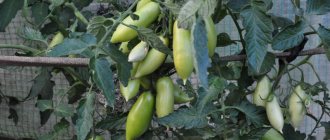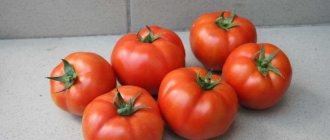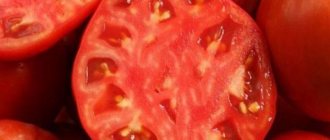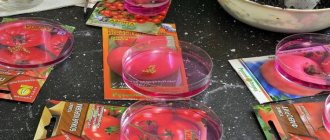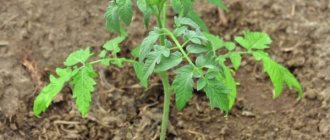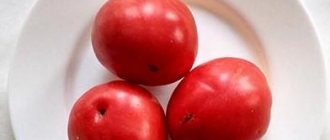Description of culture
The mid-season tomato Makhitos f1 was bred by the Dutch family enterprise Rijk Zwaan, a recognized leader in the global vegetable breeding market. It was included in the State Register of the Russian Federation in 2012.
The culture is intended for cultivation in protected soil. The bushes are indeterminate and require staking and formation into 1-2 stems. The plant is densely overgrown with foliage and has a powerful rhizome.
The main advantage of the hybrid is the ability to form ovaries in cold weather and under conditions of sudden changes in average daily temperature.
In the photo - Mahitos f1 tomatoes.
The distinctive features of the hybrid are presented in the table.
| Indicators | Characteristic |
| Weight | 200–300 g |
| Form | Round, slightly flattened |
| Fruit coloring | Red |
| Leaves | Large, green and dark green in color |
| Type of inflorescences | Intermediate |
| Number of slots | From 4 to 6 |
| Pulp | Juicy, sweet, high in sugar |
| Taste qualities | Excellent |
| Skin | Smooth, dense |
| Purpose | Universal |
| Bush height | 1.8–2.5 m |
| Ripening period | 90–100 days from sowing |
| Productivity | 5–6 kg/m² or 10 kg per bush |
| Sustainability | Verticillium wilt, fusarium wilt, cladosporiosis, tobacco mosaic virus |
| Transportability | High |
Tomato Makhitos: variety cultivation technology
Tomatoes Mahitos: photo
How a tomato will develop is influenced by 2 main factors: nature and man. No one can interfere with nature. Although it is possible to provide shelter for plantings from unfavorable conditions.
The second factor is the person, everything is clear here, everything depends on ourselves. How to care for tomatoes: water, feed, maintain temperature conditions and microclimate in closed ground, form a bush. The main thing here is competent agricultural technology.
How to properly water and feed the Machitos tomato
Let's start with the bad. If there is too much watering and feeding, the bushes will simply become fat. That is, a lot of leaves will grow, and the growth of the stems will be accelerated. The bushes will grow vigorously, but this is not necessary. The ovaries will appear later than necessary; there will be an increase in extra stepchildren. If you let the tomatoes go like this, it will be quite difficult to restore them.
If fattening has already begun, and the gardener doesn’t care about it, then the harvest will be poor: small tomatoes, and they will also ripen late.
Useful tips
- Watering should be in moderation. We increase the dosage after 3-4 brushes appear.
- Regulating the water dosage during drip irrigation is more difficult. Here it is necessary to adjust the rate of each of the droppers near the plants. If a watering tape is laid in greenhouse conditions, then the rate is adjusted according to the watering time.
- When there is a sharp cold snap, watering is reduced or suspended. If the greenhouse is unheated, then it is useless to water; the tomatoes will not drink it because it is cold.
- Minimal use of minerals is necessary to feed tomatoes. They begin to fertilize after 3 tassels have formed.
In general, follow the norm in everything, and the plants will thank you for this. After all, an excess of water or fertilizing is not good.
Tomato Machitos f1: video
How to adjust the color intensity of Mahitos tomatoes
The description states that after the tomatoes are ripe, they become a deep red color. But uneven or unsaturated coloring of tomatoes still occurs. If the color is uneven, then this is most likely due to improper watering, which should have been balanced.
But most experienced vegetable growers claim that they watered the bushes according to the rules. Perhaps this is how it all happened. And maybe the reason is insufficient feeding. But you don’t need to immediately run and fertilize the bushes with all the mixtures. There are signals that can help you find out what tomatoes are missing.
If there is not enough potassium , the coloring will be uneven. If you add potassium to the soil, everything will fall into place. The tomatoes will turn a deep red evenly.
Manganese will accelerate the coloring and brightness of fruits . If there is not enough potassium, then there is no need to add manganese. Since even if the coloring accelerates, this does not mean that it will be uniform.
These two mineral elements must be added in balance. Only then will the harvest be beautiful.
Temperature conditions for growing tomato Mahitos
The hybrid tomato variety Mahitos is resistant to weather and climate. The bush is strong and tolerates most changes in the microclimate of greenhouse conditions. This also applies to lowering temperature conditions.
If the leaves are exposed to the sun, it’s not scary. The variety is not afraid of burns, but, naturally, everything has its own measure. But let's not experiment with this matter. After all, you just need to maintain high temperature conditions in closed ground, since the hybrid variety is heat-loving.
Should I remove the foliage of a Machitos f1 tomato?
Excess leaves take juice from the bushes. If there is a large amount of foliage, then the tomatoes become smaller. Their ripening period is long, the taste is not so sweet. But it is also forbidden to pick off many leaves.
Thickened bushes are a feature of the variety. If you remove a large number of leaves, the plant will become depressed. Because the leaves are its cooling, moisture- and air-permeable systems. It is necessary to pluck the bushes in parts. The foliage breaks off only on the lower tiers and in the place where it interferes with the ripening of tomatoes.
Growing seedlings
Hybrid Machitos is grown through seedlings. Sowing begins 60–65 days before planting in the ground - at the end of February or beginning of March.
Preparing the soil and sowing seeds
Seeds are sown in a light, nutritious substrate . To do this, mix turf, peat and river sand in equal proportions in a large bucket. The soil is first disinfected with a pink solution of potassium permanganate or heated to 100 °C in the oven.
The seed material does not need to be disinfected or treated with growth stimulants; the manufacturer takes care of this. The germination rate of Machitos seeds is close to 100%.
The seedling boxes are filled with moist soil and the seeds are laid out to a depth of 1 cm with an interval of 3 cm. A film is stretched on top or glass is placed on top to create a greenhouse effect. To prevent mold, air the soil daily for 15–20 minutes. Shoots appear at a temperature of +25 °C in 3-4 days.
Seedling care
Seedlings develop quickly and need nutrition. Before transferring to a permanent place, the plants are fertilized once every two weeks with complex compounds “Agricola”, “Fertika”, “BioMaster”.
Picking into separate containers is carried out after the appearance of 3-4 true leaves. Seven days after this, the first portion of fertilizing is applied.
A week before planting, the last fertilizing is applied to the soil.
Watering is necessary moderately, once every 5 days.
Advice . To check if the soil is dry enough, stick your finger into it. If the soil is wet, delay watering for 1-2 days.
Measures to protect against diseases and pests
Tomato Machitos is immune to nematodes, verticillium, cladosporiosis and tobacco mosaic. Despite the high genetically determined resistance to pests, it is recommended to treat tomatoes against:
- gray rot;
- anthracnose;
- streak;
- late blight.
To prevent weakened immunity, it is important to maintain high light levels and avoid excess moisture. If signs of disease appear, you should remove the affected fruits, increase the temperature in the greenhouse, and reduce the humidity level.
After this, it is highly advisable to establish the type of violation and treat the above-ground parts with a special solution. If the roots begin to rot, then you need to treat the underground part of the plant with copper sulfate and change the layer of substrate in which the tomato grows.
On tomatoes you can notice the proliferation of whiteflies, bedbugs and mites, mole crickets and Colorado potato beetles, and wireworms. They attack leaves and the area around them. The first insect is a small butterfly that breeds on the inside of the leaf. The larva feeds on the sap of the plant and forms a viscous secretion, preventing it from breathing.
Bedbugs come in different sizes; the shoots growing next to the weeds are the first to be affected. A lesion can be suspected by the appearance of brown or white spots on the skin. The leaves of the plant curl and die.
The Colorado potato beetle lays larvae on the back of the leaves, and the offspring appear after 10 days. If they grow, they eat the bush in 3-4 days.
The mole cricket is a large beetle that digs tunnels underground. It damages the roots of the tomato, which causes its death.
The only way to get rid of parasites is to timely treat the bush. It is best to prevent pests from appearing and water the bush for preventive purposes. To do this, you need to deeply plow the soil in the fall and add a solution of chemicals before planting.
For reference! As an additional preventive measure, tomatoes are planted away from other nightshade crops (potatoes, eggplants, peppers).
Agricultural technology of tomatoes
Grown tomato bushes are planted in greenhouses from late April to late May. It all depends on the region and the time of sowing the seeds. In the south this happens earlier, in the north - later.
The success of growing a hybrid depends on the frequency of watering and fertilizing. In general, the culture is unpretentious and withstands bad weather.
Landing
The soil is prepared in advance:
- in the fall they dig up, add a bucket of humus and a glass of wood ash per 1 m²;
- in the spring they are loosened again and disinfected with copper sulfate.
The holes are dug to a depth of 20 cm, a hot solution of potassium permanganate is poured into each and the plants are transferred along with the earthen lump. There are no more than three bushes per 1 m². Planting pattern – 40×70 cm.
